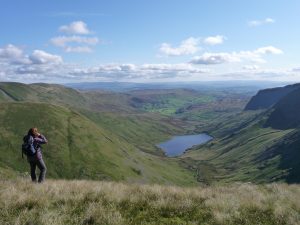Kent: Main Issues
Physical Modification

Kentmere Valley © James Cook
- Historically exploited for power and water supplies
- 63 weirs across the catchment. Built primarily to generate power and control the supply of water to local industry.
- Kentmere reservoir was constructed in the mid 19th century to control the flow of water for the benefit of water mills downstream.
- 55% of the main channel shows some form of erosion
- 27% of banks have been reinforced
- 21% of banks have been realigned (Orr et al., 2000)
- Some modification is necessary such as Kendal flood protection scheme.
Modifications affect the natural functioning of a river system, restricting the natural movement of water, gravel and fish species, disrupting migratory routes of a number of once common species such as Atlantic Salmon.
Lack of Habitat
- Freshwater pearl mussel populations have declined dramatically. They can live over 100 years if the conditions are right, however, they rely upon clean gravels, good water quality and suitable flows, as well as a healthy fish population. This sensitivity makes them a good indicator of river system health.
- Steep valley sides focuses pressures along valley bottoms and river banks.
- Intensive grazing can cause poaching and soil compaction leading to increasing volumes of sediment entering the river. This reduces clean gravel habitat, leading to a loss in potential fish spawning areas.
- 55% of the river banks have no or limited vegetation cover and are at greater risk of erosion.
- There is a lack of woodland cover, please click the following link to find out more: Forestry Cover: Kent Catchment
Water Quality
- Diffuse pollution is widespread pollution arising from rural and urban land use activities where it is hard to pinpoint a source.
- Agriculture, forestry and mining all contribute to diffuse pollution in the catchment: collectively this can have a big impact.
- Pollution from excessive fertilisers, nutrients and pesticides can enter the river at an economic loss to the farms causing a decline to the water quality of the river.
- Other common sources include road run-off and poorly maintained septic tanks.
- The River Kent and tributaries is failing to meet some of its SSSI/SAC targets for phosphorus.
Flood Risk
- Storm Desmond in December 2015 was the largest flood ever recorded on the catchment. Approximately 2,150 properties were flooded in Kendal.
- The steep nature of the catchment leads to a flashy response to rainfall which rapidly arrives at towns and villages lower down the catchment.
- A number of defences and flood storage schemes have been implemented across the catchment, with major modifications occurring through Kendal in the 1960s.
- Investigations in to Natural Flood Risk Management techniques across the catchment to help reduce flood peaks before they reach any population centres.
- Cumbria Floods Partnership and the South Cumbria Catchment Management Group, hosted by South Cumbria Rivers Trust, are developing projects in the catchment.
Invasive Species
- Kent Invasives Action group has carried out a huge amount of work across the catchment over the last 10 years.
- Himalyan Balsam is present but has been controlled at a number of locations. It may look beautiful to many (including bees) but in fact creates a monoculture, out-competing native species and dying back in winter to leave bare banks which are susceptible to erosion.
- Himalyan Balsam is often referred to as ‘junk food’ for bees.
- Giant Hogweed is also present in the catchment and presents a danger to human health, causing severe blistering if touched.
- The River Kent and tributaries is the last stronghold of white-clawed crayfish in Europe, being present throughout the catchment.
- Across Europe white-clawed crayfish have seen a 50-80% decline and are now classified as ‘endangered’ on the IUCN red list of threatened species
- White-clawed crayfish are under threat from invasive non-native crayfish: American signal crayfish. This introduced species out-competes native white-clawed crayfish for food and habitat.
- The American signal crayfish carries a fungal plague which rapidly kills white-clawed crayfish.
For more information please have a look at our catchment maps.
